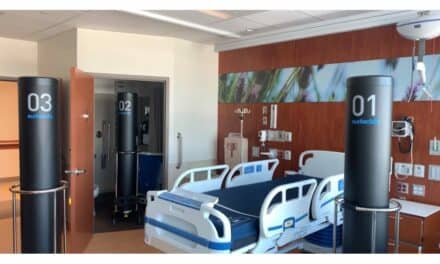 |
An uninterruptible power supply (UPS) has a knack of generating misery. Even so, the UPS has proven itself to be a valuable tool and an undeniable savior of data and operating systems. The power of a UPS is in the security we all rely on to protect our computers from interruptions, delays, and loss of information. Since the introduction of the UPS, the device has been limited to use in the information technology (IT) area, primarily with desktops, tower servers, and stand-alone systems. The UPS has now migrated into the health care sector. The IT and health care electronic data systems are similar in how they act, but very different in how they affect information.
The primary job of a UPS is to ensure that power is not interrupted. The UPS is designed to prevent loss of power and the flow of information for a determined length of time, which gives the user time to power the system down to prevent losing data. The power loss may be temporary, or the power could be lost for an undetermined amount of time.
When a UPS fails, it fails in different ways—the difference being in the way each system reacts during a UPS outage or intermittent outage. A UPS can fail as a meltdown or a hard failure. A hard down is when the power is off and the system crashes. This may cause the computer hard drive to crash—or worse, to self-destruct. The other failure may be intermittent, where the power cycles off and then on again, interrupting the flow of patient data.
The critical care patient monitoring system depends on power to keep the patient data flowing. With power failures, the use of UPS in the critical care environment may have a deleterious effect on patient care. In a case where there is a critically ill patient or a life-threatening condition, this may be hardest on the patient’s staff.
In most cases a, critical monitoring system will also be powered by an emergency power generator backup at the outlet. The emergency power generator is there to ensure that the power to critical systems is present, and only minor disruptions in power should affect the data flow of patient information. When the emergency power is transferred to the generator, there is a 0 to 6 second delay, sometimes causing a momentary power loss due to the transfer switching from the power provider to the hospital-generated power. This is common to all hospital-generated power. The amount of delay (power loss) is not significant enough in itself to cause a major failure, although it is possible. Therein lies the argument, the pros and cons of UPS backup power. This minor disturbance in power loss means that the data from patient monitors is disrupted briefly due to the switching process. Commonly referred to as a flicker, the threat to patient data comes from prolonged, and/or repetitive disruptions in power or data loss.
Real problems start when a UPS that has a weakened or defective battery cannot support the load needed to keep the system up and running. The computer or server that relies on the UPS battery to keep the system running may compromise data by a low voltage or depleted battery. Because of power loss, the flow of vital information to the nursing staff has now been interrupted, and patient safety has become compromised.
A UPS has a voltage tolerance typically in the 90V to 130V AC range. A compromised situation may occur when the line feed from the power source drops to below the tolerances of the UPS unit. Typical power line drops may fall below 90VAC, which may not have any effect on a critical care system as the system stands. However, now that the UPS is in the loop and your battery condition is in question, your system may be vulnerable to patient data loss.
Even though the UPS unit is plugged into an emergency power outlet, it can cause problems. Recommendations are to disconnect the battery portion of the UPS from the system and then use only the surge protection of the UPS so your system will not be at risk of UPS failure.
What’s on Your Mind?
Got a gripe? A recommendation? Does someone or something deserve praise? Share your opinions and insights with your peers. Soapbox columns should be 700 to 750 words in length and can be e-mailed to .
You may find that you have no control over the supplied power to your facility. You may take further action to monitor the line voltage into the critical care area of concern. I prefer to mitigate the chance for failure by relying on the surge protection and the emergency power from the generator.
By trying to prevent power problems, the UPS has in fact created additional ones. The UPS system is a questionable device if used in the wrong area of health care. It is at the discretion of the health care service provider and/or the hospital to determine if the UPS system has a place in the critical care area.
Raymond R. Patton, SBMET, CE, is a certified technical communicator, Fountain Valley Regional Hospital, Fountain Valley, Calif. For more information, contact .




